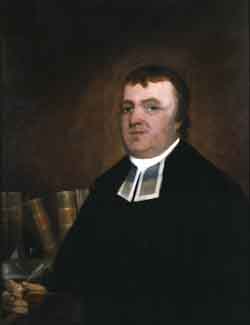Indeed, Belknap recorded information so early that it might not even qualify as historical.
In the fall of 1775 Belknap visited the Continental Army camps around Boston, checking on the New Hampshire troops and observing the siege. He kept a diary during that trip, published by the M.H.S. in 1860.
A few days after returning to his town of Dover, New Hampshire, Belknap added this entry dated 25 October to his travel diary:
Mr. Waters informed me, that the design of the regular troops, when they marched out of Boston the night of April 18, was discovered to Dr. [Joseph] Warren by a person kept in pay for that purpose. That they had a design upon the stores at Concord the week before, and dressed victuals for their men; but, by the dressing an extraordinary quantity in the barracks, the design was discovered. They then marched out only as far as Watertown, as they had frequently done before in the day-time, for an airing, and returned before night.Historians have treated this source with skepticism. In fact, despite Belknap’s record being available in a leading historical journal since before the Civil War, almost no book has discussed the “person kept in pay” by Dr. Warren and his colleagues.
But, on the night of April 18, they took every imaginable precaution to prevent a discovery. Their meat was dressed on board a transport-ship in the harbor. Their men were not apprised of the design, till, just as it was time to march, they were waked up by the sergeants putting their hands on them, and whispering gently to them; and were even conducted by a back-way out of the barracks, without the knowledge of their comrades, and without the observation of the sentries.
They walked through the street with the utmost silence. It being about ten o’clock, no sound was heard but of their feet; a dog, happening to bark, was instantly killed with a bayonet. They proceeded to the beach under the new powder-house,—the most unfrequented part of the town; and there embarked on board the boats, which had their oars muffled to prevent a noise, and landed on Phips’s Farm, where they were met by the infamous Capt. Beeman, and conducted to Concord.
Notwithstanding all this secrecy, the following circumstances contributed to their discovery. Numbers of people were jealous, and kept a vigilant eye upon them. It was observed, that, two days before, general orders were given out that the light infantry and grenadiers should be excused from duty. The boats were observed to be launched from the transports. In the afternoon of April 18, an uncommon number of officers were seen walking up and down the Long Wharf; and a party of nine rode out of town with their blue surtouts, and passed through Cambridge just before night, riding very slowly; and, being followed by a person who suspected some bad design, they damned him, and told him not to keep so near them. Late in the evening, a light-infantry man was seen in a retail shop with his accoutrements on.
These circumstances being communicated to Dr. Warren, he applied to the person who had been retained, and got intelligence of their whole design; which was to seize [Samuel] Adams and [John] Hancock, who were at Lexington, and burn the stores at Concord. Two expresses were immediately despatched thither, who passed by the guards on the Neck just before a sergeant arrived with orders to stop passengers. Another messenger went over Charlestown Ferry; so that the alarm was given several hours before the troops arrived at Lexington.
There seem to be two problems with that part of the story. First, I can’t help but suspect that American authors felt an ideological aversion to the idea of the Patriots bribing an informant. It was much more reassuring to stress the unity and perspicacity of Bostonians watching the soldiers prepare. And imagining Thomas Gage betrayed by his wife, or Margaret Gage torn by conflicting allegiances to husband and country of birth, is more dramatic.
That distaste opened the door to being skeptical about this account on grounds of provenance. How would this otherwise unidentified “Mr. Waters” in Dover, New Hampshire, have any reliable information on Dr. Warren’s secret source down in Boston? Was this statement anything more than well-traveled camp gossip festooned with unconfirmable claims?
David Hackett Fischer used Belknap’s statement in Paul Revere’s Ride, but only partially. He accepted that Dr. Warren “applied to” his best-placed source late on 18 April after hearing from other sources and before sending out William Dawes and Paul Revere, the “Two expresses.” But Fischer set aside the detail about “a person kept in pay” and instead focused on the possibility that that source was Margaret Gage.
In a 2014 article, Derek W. Beck, author of Igniting the American Revolution, discussed this source and concluded, “Mr. Waters’s statement sounds like an American concoction.” Unsupported by other evidence and judged against more reliable sources, Beck decided, this story reflected Waters’s wish to look like he had inside info and Belknap’s wish to believe him.
To make this account into useful evidence, we need to answer questions like: Who was Belknap’s acquaintance, the mysterious “Mr. Waters”? Did this person really have connections in Boston’s Patriot leadership? Can any specific, non-public details of this account be confirmed by other sources? And does answering those questions lead us any closer to identifying the “person who had been retained”?
Answering those questions might require spending years studying small details of Revolutionary New England, looking at a plethora of sources both print and digital, and being crazy enough to think they matter.
TOMORROW: You rang?

They matter.
ReplyDeleteI do miss the "Tis to laugh" option.
ReplyDelete